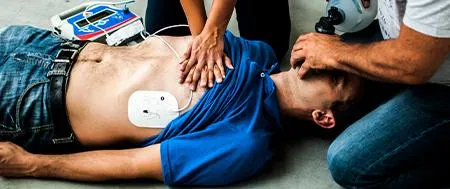Rutland First Aid Training
BLOG

Resuscitation of Victims in Drowning
What is Drowning?
Drowning is when someone is unable to breathe because their nose and mouth are submerged in water, or in another liquid.
Drowning Statistics
In the UK, there are approximately 350 accidental deaths from drowning each year. Drowning is commonest in males aged 20–30, and occurs mostly in inland waters (e.g. lakes, rivers) and during summer months.
What does Drowning look like?
Often silent or quiet—respiratory system designed to breath first, speak second
When sinking, a victim can’t keep their head above water long enough to exhale, inhale, and call for help
Not flailing for help; their arms are lateral or down, to push themselves up
Often fail to kick, wave for help, or move toward a rescuer due to the Instinctive Drowning Response
They may struggle for 20-60 seconds before going under the surface
How do you do Resuscitation after a water rescue?
As soon as the casualty has been rescued from the water, check for a response by opening the airway and checking for signs of life. A drowning victim, rescued from the water within a few minutes of submersion, is likely to exhibit abnormal (agonal) breathing. Do not confuse this with normal breathing
Ask someone to call 999 or 112 for medical help.
If the person is unresponsive and not breathing, give them five initial rescue breaths, supplemented with oxygen if immediately available, and then start Chest Compression(CPR). CPR should include rescue breaths because the casualty will be hypoxic (low in oxygen) and therefore compression-only CPR is likely to be ineffective.
If the victim has not responded to initial ventilations, place them flat on their back on a firm surface before starting chest compressions.
If you are on your own and without a phone to call for help, perform CPR for 1 minute before going to find help.
Then start CPR and give 30 chest compressions, then two rescue breaths. Keep giving CPR at a ratio of 30:2 until help arrives, the casualty regains responsiveness, or you’re too exhausted to keep going.
If they start breathing again at any time, treat them for hypothermia (as hypothermia is common after drowning) by covering them with warm clothes and blankets. If they recover completely, replace their wet clothes with dry ones.
Keep checking breathing, pulse and level of responsiveness until help arrives.
What are your Next Steps?
So, regardless of who you are, you can join any of our first aid courses and the CPR and AED course will teach you the skills required to assist in a post-drowning incident.
Hear what our first aid students have to say...
TESTIMONIALS


A really good training course, very professionally presented by Tracy. I’ve been on lots of training courses over the years and too often they can be soporific! Tracy is one of those rare training professionals who can deliver training and keep a person interested all day! Great course. Highly recommended!

Alan Eager
Google Review


Rutland first aid are professional yet kept the courses fun and interactive and use some very interesting props. As a driving instructor I wanted to be able to deal with any issues with my students but also any issues I may come across on the roads. Highly recommended.

James Dames
Google Review


Couldn't recommend Tracy and her team enough for a first aid course. Having to renew it every 3 years used to send me to sleep. Not with these guys! Professional, up to date and with lots of toys to play with, without the death by powerpoint.

Mike Gould
Google Review

Here at Rutland First Aid Training we strive to provide high quality, personalised, fun and informative first aid courses.
Our courses are recognised by HSE, Ofsted and follow ILCOR guidelines.
Short Cuts
Find what you are looking for:
Dental CPD Courses
Get In Touch
If you have any questions or would like to discuss your requirements in further detail, our team are always happy to assist you.
1 Old Station Yard, Whissendine Road, Ashwell, Rutland LE15 7SP
@ 2025 Copyright Rutland First Aid Training. All rights reserved.
Rutland First Aid Training is a trading name of Dive Rutland Limited. Company No: 9433835.




